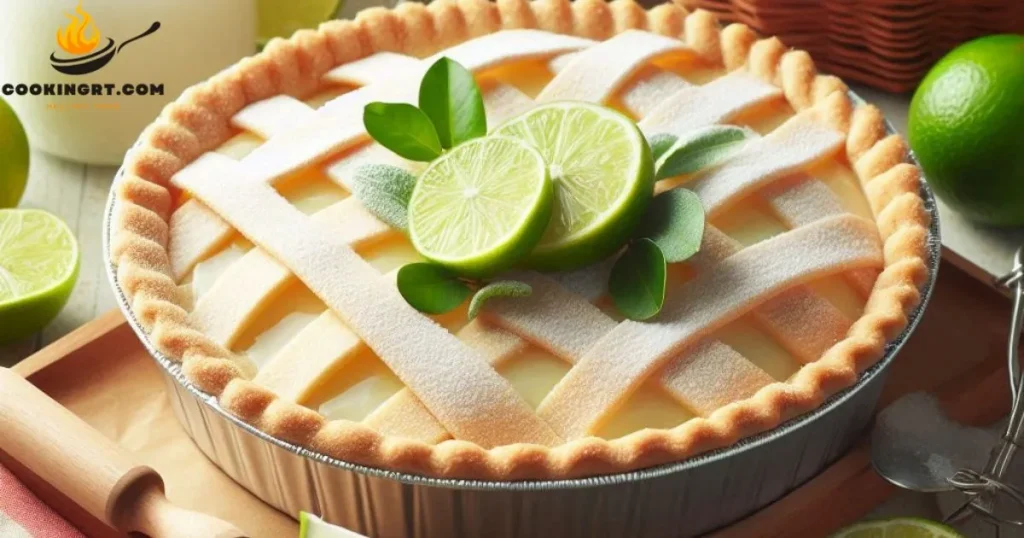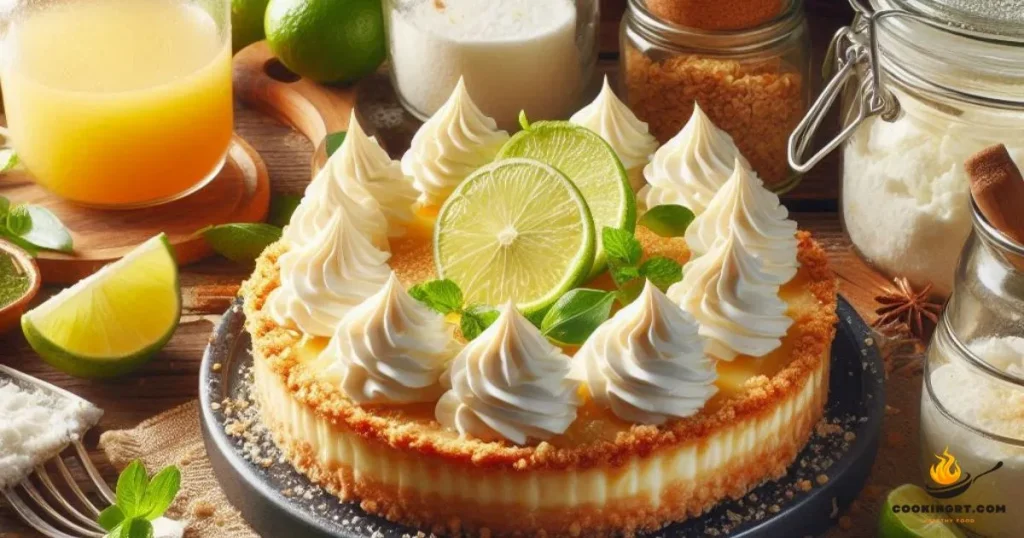Yes, you can freeze key lime pie, and it’s a great way to preserve its delicious flavor and texture for later enjoyment. Whether you’re making it ahead for a special occasion or simply want to save leftovers, freezing key lime pie is both easy and effective. To maintain its creamy consistency and tangy zest, it’s important to follow the right steps in freezing and thawing. Here’s everything you need to know about how can you freeze key lime pie and still enjoy its refreshing taste.
Freezing Key Lime Pie: A Quick Guide

When it comes to freezing Key Lime Pie, you can preserve its zesty flavor and creamy texture for later enjoyment. To begin, ensure your pie is completely cooled before wrapping it tightly in plastic wrap or aluminum foil, preventing freezer burn. For optimal freshness, consider placing it in an airtight container. When you’re ready to indulge, simply thaw the pie in the refrigerator overnight; this allows it to regain its original consistency.
If you’re planning to freeze a homemade Key Lime Pie, avoid adding whipped cream until after thawing to maintain its fluffy topping. Remember, the key to a delicious frozen treat is to keep it at a constant freezer temperature and enjoy it within 1 to 3 months for the best taste!
Preparing for Freezing
Freezing is a fantastic way to preserve fresh foods, extend their shelf life, and reduce food waste. By understanding how to properly prepare items for freezing, you can ensure that your ingredients remain nutritious and flavorful.
Choose the Right Foods
Not all foods freeze well. It’s important to know which items are suitable for freezing. Fruits and vegetables like berries, peppers, and green beans are ideal candidates. Opt for fresh, ripe produce, as they will maintain better texture and flavor when thawed.
Clean and Prep Your Food
Before freezing, wash and prepare your food properly. Wash fruits and vegetables thoroughly to remove any dirt or pesticides. Peel, chop, or slice as needed. For certain vegetables, like broccoli and carrots, blanching before freezing can help retain their color, flavor, and nutritional value.
Use Proper Packaging
To prevent freezer burn and preserve quality, use freezer-safe containers or bags. Remove as much air as possible from the packaging to create a vacuum seal. Label each container with the name and date to keep track of your frozen inventory.
Maintain Freezer Temperature
Keep your freezer at a consistent temperature of 0°F (-18°C) or lower. This ensures that your frozen food remains safe and maintains its best quality. Avoid overloading your freezer, as this can lead to uneven temperatures and compromised food quality.
Know Thawing Techniques
When you’re ready to use your frozen items, thaw them safely to prevent bacterial growth. The best methods include refrigerator thawing, cold water thawing, or microwave thawing.
Read More: Golden Jubilee: 50 Spectacular Birthday Celebration Idea
Wrapping the Pie Properly

Wrapping your pie properly is crucial for preserving its freshness and flavor. It prevents freezer burn and maintains the quality of your pie for longer. Whether you’re storing a baked pie or preparing one for the freezer, the right wrapping technique can make all the difference.
Materials Needed for Wrapping
To wrap your pie correctly, you’ll need a few essential materials:
- Plastic Wrap: A tight seal is important to keep out air.
- Aluminum Foil: Ideal for covering baked pies and adds extra protection in the freezer.
- Freezer Bags: Perfect for storing unbaked pies and can be sealed tightly to prevent air exposure.
Step-by-Step Wrapping Instructions
Follow these simple steps to wrap your pie properly:
- Cool the Pie: Ensure your pie is completely cooled to avoid condensation, which can lead to sogginess.
- Use Plastic Wrap: Wrap the pie tightly with plastic wrap, ensuring there are no gaps.
- Add Aluminum Foil: For additional protection, wrap the plastic-covered pie with aluminum foil, especially if it will be stored in the freezer.
- Label and Date: Use a marker to label your pie with the type and date of wrapping. This helps keep track of freshness.
Best Practices for Freezing and Storing
When freezing your pie, it’s essential to follow best practices:
- Freeze Immediately: To lock in freshness, freeze your pie as soon as it’s wrapped.
- Store in a Flat Position: Place your wrapped pie in a flat position in the freezer to avoid any distortions.
- Thawing Tips: When ready to bake, thaw your pie in the refrigerator overnight for the best results.
Also, Read More: What Does An Espresso Martini Taste Like?
Best Storage Practices
Proper storage is essential for maintaining the quality and longevity of your items, whether they are household goods, clothing, or perishable items. Start by choosing the right containers; opt for clear, labeled bins that allow easy identification and organization. Ensure that you clean and dry items thoroughly before storing them to prevent mold and deterioration. For temperature-sensitive items, always monitor the climate; use temperature and humidity controls to protect against fluctuations that could damage your belongings.
Additionally, avoid overcrowding storage spaces; this not only allows for better air circulation but also makes it easier to access and retrieve items when needed. Finally, consider rotating stored items; regularly check and use items that may expire or deteriorate over time, ensuring that your storage remains functional and efficient. Implementing these best practices will help safeguard your possessions and streamline your storage solutions.
Freezing Time Limits
Sure! Here’s a short table defining the key aspects related to Freezing Time Limits with well-crafted material under each heading.
| Heading | Description |
|---|---|
| Definition of Freezing Time | The period during which legal actions or claims must be initiated before they become unenforceable. |
| Purpose of Freezing Time Limits | To ensure timely resolution of disputes and to prevent parties from delaying necessary actions, promoting judicial efficiency. |
| Types of Freezing Time Limits | Includes statutory time limits (set by law) and contractual time limits (agreed upon by parties). |
| Consequences of Exceeding Limits | If a claim is filed after the expiration of the freezing time limit, it may be dismissed, and the party may lose their legal right to pursue the case. |
| Exceptions to Freezing Time Limits | Certain circumstances, such as fraud or concealment, may allow for extension or tolling of the time limits. |
| Jurisdictional Variations | Different jurisdictions may have different freezing time limits based on local laws, making it crucial to understand the applicable rules. |
Thawing and Serving Tips

Here are some helpful thawing and serving tips to ensure your food is safe and delicious:
Thawing Tips
When it comes to safely thawing your food, it’s essential to prioritize food safety to avoid any health risks. Here are some effective methods:
Refrigerator Thawing
The best way to thaw frozen food is in the refrigerator. This method keeps the food at a safe temperature (below 40°F) and allows for even thawing. Simply transfer the food from the freezer to the fridge and let it thaw gradually. This method may take several hours or overnight, depending on the size of the item.
Cold Water Thawing
If you’re short on time, the cold water method is a quick alternative. Place the food in a leak-proof plastic bag and submerge it in cold water, changing the water every 30 minutes. This method can thaw food in a few hours, but it’s important to cook the food immediately after thawing.
Microwave Thawing
The microwave is the fastest way to thaw food, but it can result in uneven thawing. Use the defrost setting and follow your microwave’s instructions for thawing various types of food. Be cautious as some areas may begin to cook, so it’s advisable to cook the food immediately after microwaving.
Serving Tips
Serving food properly enhances the dining experience and maintains the quality of your dishes. Here are some essential serving tips:
Temperature Matters
Ensure that hot foods are served hot (above 140°F) and cold foods are served cold (below 40°F). Using food thermometers can help you maintain the right temperatures, ensuring food safety and optimal flavor.
Garnishing and Presentation
A visually appealing presentation can elevate any dish. Consider garnishing with fresh herbs, spices, or colorful vegetables to enhance the aesthetic and taste. Utilizing proper plating techniques can make even simple meals look gourmet.
Serving Sizes
Be mindful of serving sizes. For a more enjoyable experience, serve appropriate portions that allow guests to savor the dish without overwhelming them. Consider providing smaller servings and allowing for seconds to promote sharing and enjoyment.
Also, Read More: How Many Calories In a Sushi Roll?
Preserving Taste and Texture

When it comes to cooking, preserving taste and texture is paramount. Whether you’re preparing meals at home or managing a restaurant kitchen, understanding the nuances of ingredient preservation can elevate your culinary creations.
Cooking Techniques
Utilizing the right cooking techniques is essential for maintaining the integrity of flavors and textures. Techniques such as sous vide cooking, steaming, and blanching can help retain moisture and enhance the natural taste of ingredients. For instance, sous vide cooking locks in flavors while ensuring that meats remain tender and juicy.
Storage Methods
Proper food storage plays a significant role in preserving taste. Techniques like vacuum sealing, freezing, and canning help extend shelf life while keeping food fresh. For example, freezing fruits and vegetables at peak ripeness ensures that they retain their original taste and texture, making them ideal for smoothies or cooking later on.
Ingredient Selection
Choosing high-quality ingredients is vital. Fresh, organic produce not only tastes better but also retains its texture longer. Opt for seasonal fruits and vegetables, as they are harvested at their peak, ensuring maximum flavor. Additionally, using herbs and spices can enhance taste without compromising texture.
Marination and Seasoning
Marinating meats and vegetables helps infuse flavor while also tenderizing them. Using acidic ingredients like vinegar or citrus juice in your marinades can enhance taste without overcooking the item, preserving the desired texture.
Avoiding Overcooking
One of the most critical factors in maintaining taste and texture is avoiding overcooking. Monitoring cooking times and temperatures ensures that ingredients do not lose their natural flavor or become mushy. Techniques like sautéing and quick roast can help achieve a perfect balance.
Conclusion
Freezing key lime pie is an excellent way to enjoy this refreshing dessert at your convenience. When done correctly, you can preserve its unique flavor and creamy texture for future enjoyment. It’s important to note that can you freeze key lime pie? Yes, you can!
To achieve the best results, ensure the pie is completely cooled before wrapping it tightly in plastic wrap or aluminum foil. For added protection, place the wrapped pie in an airtight container or a heavy-duty freezer bag. This method will help prevent freezer burn and maintain the pie’s integrity.
When you’re ready to enjoy your frozen key lime pie, simply thaw it in the refrigerator for several hours or overnight. This gradual thawing process will help retain its original flavor and texture, allowing you to savor each delicious bite just as if it were freshly made. Freezing key lime pie not only extends its shelf life but also makes it a convenient treat to have on hand for unexpected guests or special occasions. So go ahead and freeze that key lime pie—you won’t regret it!
Frequently Asked Questions (FAQ’s)
Q: How do you freeze key lime pie?
Ans: To freeze key lime pie, wrap it tightly in plastic wrap and then place it in an airtight container or a freezer bag to prevent freezer burn.
Q: Is it better to freeze homemade or store-bought key lime pie?
Ans: Both homemade and store-bought key lime pies can be frozen. However, homemade pies may have a fresher taste once thawed, while store-bought pies might contain preservatives that help maintain texture.
Q: What is the best way to serve thawed key lime pie?
Ans: Once thawed, serve the key lime pie chilled. You can add fresh whipped cream or lime zest for added flavor and presentation.
Q: Can you refreeze key lime pie?
Ans: It’s not recommended to refreeze key lime pie after it has been thawed, as this can compromise the taste and texture.
Q: Should you freeze key lime pie with or without toppings?
Ans: It’s best to freeze key lime pie without toppings, such as whipped cream or meringue, as they can become watery and lose their texture when thawed.




